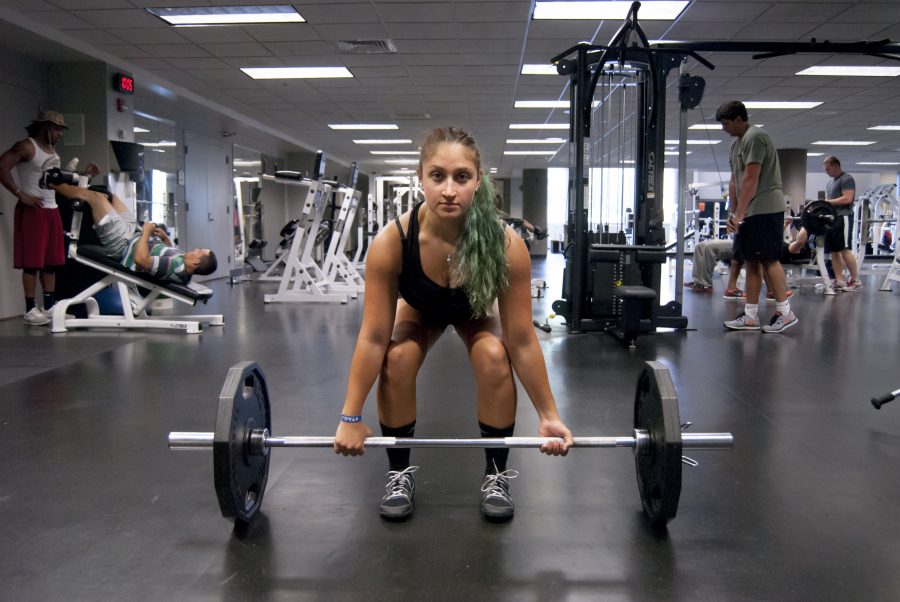As the Alabama summer sun blazes down, UA students Danielle Ra’ed and Alyssa West brace themselves to flip a 200-plus pound tire outside the Student Rec center. A few moments of struggling ensue before the tire lands on the grass with a thud and the girls stand over it, sweaty and satisfied.
“See, this is why girls in magazines use the two-pound weights,” Ra’ed said, catching her breath. “It’s so they won’t get tired during photo shoots.”
For men and women, fitness can mean very different things. Open up a men’s fitness magazine, and the pages will be littered with words like “build muscle,” “shred” and “strength.” However, in a women’s fitness magazine, words like “tone up,” “slim down” and “lose weight” appear alongside images of beautiful, fit women holding two- or three-pound dumbbells.
These photos don’t always tell the entire story, Ra’ed said.
Ra’ed, a senior majoring in psychology, and West, a senior majoring in sport and exercise science, have both been lifting weights for about three years, and two-pound dumbbells are noticeably absent from their fitness routines. Instead of completing tens, or even hundreds, of reps using light weights, Ra’ed and West opt to use heavier weights and stay within the 10-15 rep range.
“Lifting heavy is making it so 15 reps is the absolute most you can do,” Ra’ed said. “It’s not necessarily a certain amount of weight. If you can only lift five pounds 15 times for a bicep curl before your arm absolutely gives out, then that’s heavy
for you.”
Building muscle mass can provide a variety of health benefits for both men and women, including increasing metabolism, improving posture, strengthening bones and enhancing focus. However, misconceptions about weight training often prevent women from lifting heavy and achieving these benefits.
West said one of the most common misconceptions women have about weight training is the fear that lifting weights will make them “bulky” or ‘manly.”
“I think me and Danielle are perfect prime examples that that just doesn’t happen, because we train five or six times a week, as heavy as we possibly can, and have been doing it for multiple years, and we’re still very slim.”
Testosterone plays a vital role in building muscle mass. According to the National Institute of Health, male testosterone levels typically range from 300 – 1,000 ng/dL, while female levels range from 15 – 70 ng/dL. Because of this, it is nearly impossible for females to achieve a “manly” physique without years of strict dieting, lifting and often, the use of steroids.
“[Some women think] they’re gonna end up like the stereotypical bodybuilding girl,” West said. “And to do that, there’s so many other factors that are involved. For a woman to get to that size, you have to have a certain level of testosterone in you, so that’s not natural.”
Deb Dunn, who is pursuing a doctorate in exercise physiology, has been a certified athletic trainer since 1996 and a certified strength and conditioning specialist since 2008. In addition to working as an athletic trainer for Tuscaloosa County High School, Dunn works as a personal trainer at GFG Fitness and the Student Rec center.
“All of my females want toned legs, and all of my females want butts, [but] you have to do heavy weight and low reps when you’re training legs or you won’t grow and you won’t tone,” Dunn said. “And everyone says, ‘I’m doing squats, I’m doing these leg kick things, and I’m not seeing the results I want.’ And really, they just don’t understand what the muscle itself is meant to do.”
Dunn said part of her job as a personal trainer is to clear any misconceptions women might have about weight training.
“We try to help them and really attack that mental side of it to where I assure them they’re not gonna bulk, I assure them they’re not gonna get big,” Dunn said. “That’s where, to me, having a personal trainer can be a benefit.”
Sometimes, it’s not just the fear of bulking up that holds women back from weight training. The prospect of entering unfamiliar territory and the fear of embarrassing oneself can also play a role.
“It’s very intimidating going to a new place, especially it being the Rec, by yourself as a female,” Dunn said. “If I was 18 years old, I would be scared to death. I wouldn’t know where to start because there’s so many machines in there.”
Dunn, West and Ra’ed all said going to the gym with a personal trainer, or even just an experienced friend, can minimize the intimidation factor of beginning to weight train. If those options aren’t available, websites like bodybuilding.com provide step-by-step guides to a variety of exercises.
“I’ve been there,” West said. “Whenever you go into a gym, you see all these guys who are huge, and you think they’re staring at you because you don’t know what you’re doing. But actually they’re in their own little world and could care less what you’re doing.”
Another option for novice weight trainers, both male and female, is the Beginner Weight Training course, KIN 157, offered by the kinesiology department. Five sections of the course are available for fall 2014, and 33 percent of students registered are female.
“I think that society is coming around, and I think that the whole bodybuilding for women is getting bigger,” West said. “I have seen a lot more articles and stuff [saying women] can use heavier weights and you’re not gonna get bigger.”
Ra’ed and West said not only have they noticed positive physical changes from weight lifting, but positive mental changes as well.
“It teaches you not to give up,” Ra’ed said. “Like, I have one more rep of this weight that I did not think I would be lifting. Holy crap, look what I can do.”









